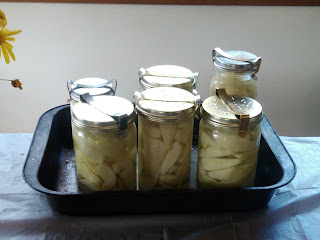

Along with snacks Petra’s house was also my designated go-to place in case of nuclear disaster. For in her kitchen Magda had a giant, dark cupboard literally groaning under the weight of hundreds of ancient bottles of preserved fruit. She was also a keen adopter of wild cats so I figured that I’d have protein, fruit and a handy source of fur in case of total world annihilation. Nuclear Armageddon aside I’d always admired Magda’s prodigious skill at preserving, and how she used these gems to ensure that she always had something delicious to offer visitors, even of the ravening teenage kind.
And so, nostalgic for someone else’s family, I decided to attend one of the Fruit and Nut Tree Network’s seasonal preserving classes taught by Anne Elliott. There were five of us in the class – myself, Kat, Suzanne, Marta who’d come all the way from Bathurst and Antonio who was visiting from South Australia. Marta who must be as talented a gardener as Petra’s mother brought with her home grown figs, lemons, persimmons and medlars while Anne had provided huge bowls of kiwi fruit and pears for preserving. I’d never seen a medlar before and concerned to get the spelling right was amused to find the following dictionary description of them:
A small tree of the rose family, the fruit of which resembles a crab apple and is not edible until the early stages of decay.
I guess we now know what Marta meant when she called them a ‘particular taste’.

And so the preserving began. We all peeled and chopped fruit, put rubber seals onto sterilized preserving bottles, and attempted, remarkably unsuccessfully, to arrange the fruit in beautiful patterns in the preserving jars. Jars filled, syrup poured in, air bubbles removed, lids clipped on and seals checked by the heart-in-mouth method of turning the jar upside down, our first batch of fruit was ready for an hour in the electric vacola set. And we were ready for some of Anne’s scones, jams and pickles. Repast over we started furiously on the pears.
A mere two hours after arriving we’d preserved five bottles of kiwi fruit and six of pears, perhaps not my fruit of choice for a strudel but if you’ve any stone fruits languishing in a cupboard here’s a rough approximation of Magda’s hunger busting strudel.
Strudel Recipe
1. a tray holds two strudels so you should always make two.
2. take filo pastry and brush each layer with a small amount of melted butter, sprinkle every second layer with some sugar and chopped nuts
3. when you think the pasty is thick enough put some preserved fruit along the longest side of the pastry leaving a fruit free section at each end. Don’t use too much fruit, this is not a fat strudel.
4. roll the fruit up in the filo ensuring that the edge of the pastry is underneath the strudel. Don’t worry about folding over the short ends leaving them open allows some of the preserved fruit’s juice to escape onto the baking pan where it will caramelise beautifully (this is Magda’s method, not mine!)
5. place on baking tray and sprinkle with sugar.
6. repeat all of above – remember two strudels are better than one
7. bake until done. If you leave it in the kitchen on the tray over the next two days it will not only disappear but the pastry will ‘wilt’ delightfully
enjoy!


No comments:
Post a Comment